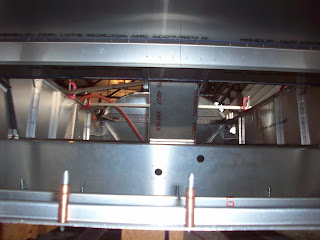Baggage Compartment floor
Here is the floor of the baggage compartment, behind the seat.
There's some structure underneath. The only somewhat tricky issue with this piece is trimming it to fit between the curved longerons.
Below is a view from underneath the floor. I traced the outlines onto the bottom of the baggage floor, and then cut the holes. There's a Z angle and an L angle supporting the floor.
Here is a picture of how the L angles from the seat back center piece attach to the baggage floor and hold it all together. The baggage floor acts as the back of a shelf unit, and fixes the front of the fuselage into shape nicely.
Same piece viewed from the front. Seat back is at bottom, and the seat back center piece is in the middle.
With all these supports attached, the baggage floor and the rear seat feel pretty well connected.

























